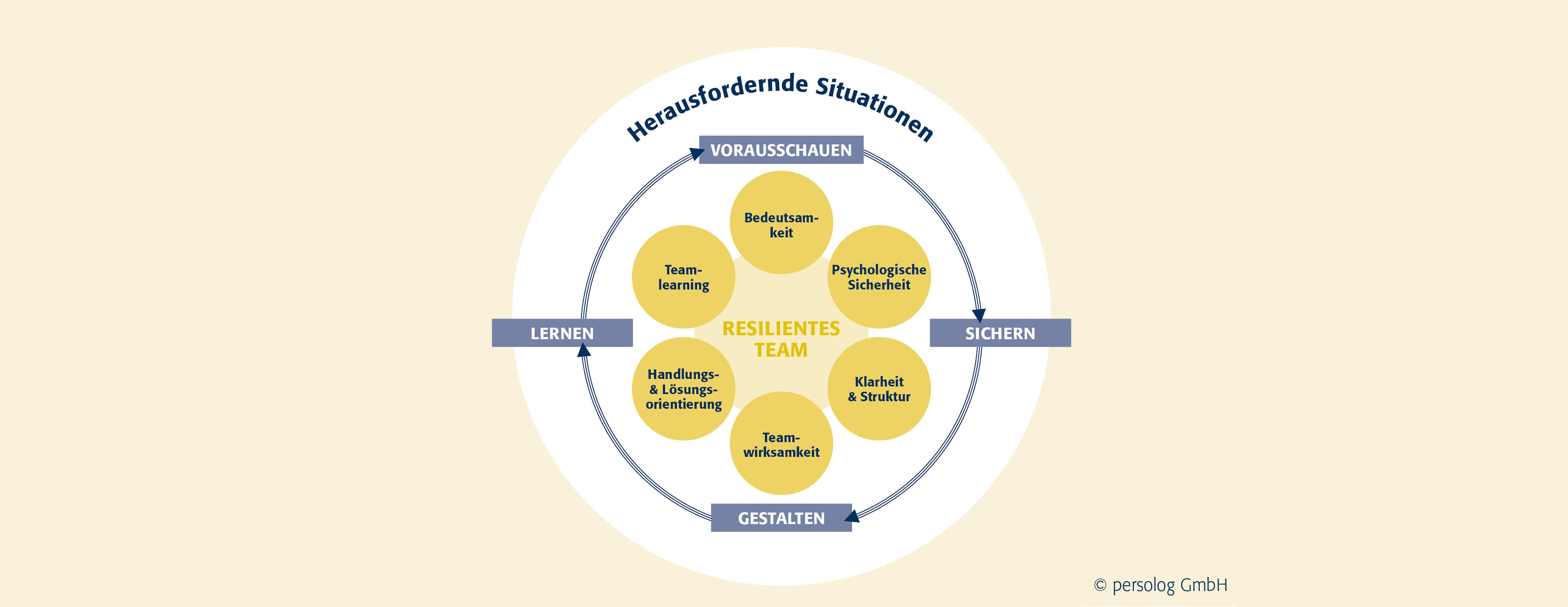We need strong teams! Teams that are capable of withstanding crises. With team resilience, this can be achieved. But what lies behind this term?
Team resilience: What’s behind it?
When delving into a new topic, it is important to first explore the definition of key terms. This establishes clarity about what one is writing or talking about. Therefore, we would like to give you an insight into the definition of team resilience at the beginning: Team resilience refers to a team’s ability to maintain its performance under difficult conditions and to cope well with stressful situations without impairment (Kainzbauer & Brandhuber, 2015, p. 4).
In other words: A team is able to maintain its performance and successfully overcome challenges, pressures, changes, or setbacks even in crises. Despite stressful circumstances, a resilient team remains productive and acquires further skills to handle stress factors even better. Like with an individual, a team’s resilience is a dynamic, active process that can also be initiated preventively (cf. Huber 2019, p. 23f.). Thus, a team’s resilience can be increased even before facing a challenge. Resilience is something a team can learn and shape.
What prerequisites should a team have to achieve all this?
The answer lies in 6 essential resilience factors of a team: significance, psychological safety, clarity & structure, team efficacy, action & solution orientation, and team learning. When a team works on building and developing these factors, it takes a decisive step to fully exploit its potential and successfully prepare itself against crises. How exactly a team can achieve this will be explained in this article.
More than resilient individuals
Now one might assume that team resilience is achieved by investing in the resilience of each individual member. While this can certainly contribute to a more resilient team, a group of resilient individuals does not necessarily make a resilient team. The resilience of a team arises from routines that the team develops together to deal with stressful situations.
Factors that make teams strong
Like personal and organizational resilience, team resilience consists not only of one factor but of many different facets that contribute to a team’s ability to navigate through crises and challenges. We have identified 6 factors that play a decisive role in this. So, what specific prerequisites must a team bring? Here you can learn more about the factors:
Significance – the first factor of team resilience
The factor of “significance” is about providing orientation and creating clarity. Does the team know why it actually exists? Does each individual know what added value their own work and that of the team provide?
A study by Tatjana Schnell (2018) showed that four components play a role in making work appear meaningful:
- Coherence – this means that the tasks align with the skills and circumstances. In other words: One gets the opportunity to contribute one’s strengths.
- Significance – this means that the contribution made is taken seriously.
- Orientation – this means that the company’s alignment aligns with one’s own values.
- Belonging – this means that people can identify with the company and feel part of something greater.
These components can be transferred to teams and their collaborative work. Values provide the team with long-term guidance on what its purpose is and what it aims to achieve. In order for the team to recognize that it is progressing and to perceive progress as successes, goals are needed. These goals represent milestones on the way to the vision. With individual and clearly formulated goals, each team member knows what they can contribute to achieving the goals and what the team needs from them.
Well-functioning teams have clear goals
Well-functioning teams work together to achieve their goals. They reflect regularly on how they can move closer to their goals together and how they can further improve their collaboration. When goals are achieved together, it creates a sense of accomplishment. These motivate and inspire further. Therefore, it is important to constantly focus on team successes, celebrate them, and discuss together how they were achieved.
You might be wondering how to achieve this in practice in your team. Specifically, this can be promoted in practice, for example, by the following guiding questions:
- To what larger whole does our team contribute meaningfully with our joint teamwork?
- What does each individual contribute to the team?
- What can the team rely on from each individual?
- What am I willing to contribute?
- Which values and vision support us in our actions?
Every team should regularly address these questions. Because if a team can no longer recognize the purpose and meaning of its work, it will not be able to work successfully in the long run. And especially in crises, it is enormously helpful to know why one is doing something. The following quote summarizes it nicely:
“When you know your why, the how always finds its way.”
Psychological safety – the second factor of team resilience
A factor that has a very high significance for team resilience is psychological safety. Behavioral researcher Amy Edmondson from Harvard introduced psychological safety as “the shared belief among team members that the team is safe for interpersonal risk-taking.” Psychological safety describes the level of security that team members feel to be able to speak up about uncomfortable truths, admit mistakes, and show vulnerability and uncertainties among each other. It is about creating a positive, trust-based working atmosphere in which team members can be themselves and open without fearing negative consequences.
What makes a trusting team atmosphere
Psychologists Jasmine Zahno and Joseph Pelrine divide psychological safety into three aspects:
- Showing vulnerability: Vulnerability can be described as a state in which one opens up and allows another person to look deep into one’s soul, and in doing so, can either be hurt or accepted and positively surprised by other people. It is the prerequisite for developing not only working through tasks but also developing creative and exploratory solutions.
- Giving trust: Trust is the expectation not to be disadvantaged by the actions of others; as such, it represents the indispensable basis of any cooperation.
- Taking responsibility: Taking genuine, felt responsibility is done through clarity and competence. Employees have clarity about the intentions of their mission and are equipped with sufficient competence to lead the mission to success.
Leaders as well as each individual team member can contribute to fostering openness for vulnerability, trust, and responsibility.
Clarity and structure – the third factor of team resilience
Leaders as well as each individual team member can contribute to fostering openness for vulnerability, trust, and responsibility.
Everything changes. And that’s why it’s important to create clarity & structure in teams. This includes clearly communicating expectations and ensuring that each team member knows what contribution they can make to overall success. There is clarity about the goals a team pursues. It is important that this is ensured even in difficult times.
At the same time, a resilient team is able to proactively shape its future. This also means: The team must regularly check and readjust its goals for topicality and appropriateness.
Transparent communication in the team
For this to succeed, attention must be paid to regular and transparent communication. Only then can the team develop new strategies to counteract critical developments as early as possible and ideally avoid them.
It is important to regularly check the answers to the following questions:
- Are the goals, roles, and milestones really clear for everyone in the team?
- Is it clear what is expected from each team member?
A well-functioning team can answer these questions with “yes”. Above all, unspoken requirements of team members should be regularly discussed to rethink old structures and develop new routines.
Method tip: The marketplace of expectations
This is where the “marketplace of expectations” is a very effective approach. Here’s how it works: Divided into groups or individually, team members are asked to write down their own job description on their “marketplace” (= on a flipchart). Then the “exchange” begins. All individuals/groups move clockwise to the next flipchart (= marketplace) and write down what they expect from the person/group standing in front of their marketplace or what responsibilities they believe that person/group has. Everyone can add contributions that the predecessors have already written down. Gradually, the marketplaces fill up with “goods” (information, perspectives, roles). After the round, the owners return to their own marketplace, read through the expectations, and reflect on them. Open questions are clarified in plenary.
Team efficacy – the fourth factor of team resilience
“Can we do it? Yes, we can.” Surely, some might still know this slogan from Bob the Builder. And that’s exactly what also describes the fourth factor of team resilience. It’s about the team firmly believing that it can overcome challenges.
More precisely, team efficacy describes a collective efficacy belief. This means that a resilient team knows its strengths and has a shared belief in its ability to cope with complex tasks, hurdles, and adversities. Even under difficult conditions, everyone trusts in the team’s performance.
A team with high team efficacy approaches challenges and dangers with more self-confidence and optimism. It can better handle the unforeseen and emerge stronger from crises.
How to strengthen team efficacy
How can this factor be strengthened concretely? It is important to understand the following: People are creatures of habit. If we always do the same things in the team, we will never find out what is possible. Therefore, team efficacy is strengthened when a team leaves its comfort zone and overcomes its fear zone; when it notices that it can learn, grow, and believe in itself more strongly. Thus, a team can face ever greater challenges – with the conviction of mastering them together.
Action and solution orientation – the fifth factor of team resilience
In concrete terms, action and solution orientation means that a resilient team is able to remain action-active even in adverse situations and to seek a common solution. A resilient team is willing to change and adapt to changes.
Crises and challenges cannot paralyze a resilient team. Because a resilient team can view a problem from multiple perspectives and deliberately focuses on the solution, not the problem. Additionally, resilient teams mobilize and activate all their energy to steer out of the problem trance as quickly as possible and to find suitable solutions together. Opportunities, strengths, and progress are the focus. This helps a team to remain capable of action even when things get tough.
Method tip: The Miracle Question
A great way to support teams in taking a new perspective is the Miracle Question. In difficult situations, one often wishes that a miracle would happen overnight and all problems would disappear overnight. However, this wise thought is rarely used – even though it can also be used in teams to open up for new thoughts, emotional worlds, and behaviors. Everything is imaginable, everything is achievable, and initial solution visions become visible in a hypothetical future.
Practically, it works like this: The team is asked the following question in plenary: “What, from your perspective, is the biggest problem in or for the team right now?” Each team member writes down their answer on a moderation card. The cards are revealed one by one. Now the biggest problem is negotiated: The cards are sorted according to how serious each problem is for the team. Everyone agrees on a card that currently represents the biggest problem in the team.
Now the miracle question is asked: “Imagine that you go to sleep and a miracle happens overnight. The next day, your problem is solved. How would you notice that your problem is solved? How would you feel?” The team collects ideas. What new perspectives have emerged? What concrete solutions can be derived for the team?
Team learning – the sixth factor of team resilience
Failure is part of life. Every team will also be confronted with failures from time to time. The exciting question is: How does a team deal with it? That’s exactly what the sixth factor of team resilience is about.
Team learning means that a resilient team is able to view setbacks as a natural part of the learning process and to draw future-oriented conclusions from these experiences. It is important to jointly reflect on negative experiences afterwards and to process them both objectively and emotionally in a constructive manner. Therefore, a team should collect the “lessons learned” together. This creates new ideas and innovative routines to equip themselves for the future.
Method tip: Sharing FuckUp Stories
Nothing is as exciting, interesting, and inspiring as true stories. While numbers and facts increase the credibility of information, telling stories creates emotional involvement. Storytelling also has a great effect in teams: When people share personal stories of falling and getting up again, so-called FuckUp stories, experiences become vivid and resources and strengths become visible.
In concrete terms, it works like this: Everyone in the team brainstorms on the topic “My FuckUp Stories” for themselves. Each person recalls particularly instructive stories from their own life where they experienced failures or setbacks. Each then chooses a story they want to share with the team and prepares for it. It is important to focus on the main message when telling the story: What was the most important learning? What helped overcome the situation? What can the team learn from it? Then, everyone who wants to shares their own FuckUp story. This creates a collective learning experience.
Now you have learned about the six factors of team resilience and methods to strengthen them. There are many other possibilities and methods to strengthen the resilience of teams, and we are happy to share them with you. The persolog® Team Resilience Model provides trainers, coaches, and leaders with an effective approach to get started right away.



